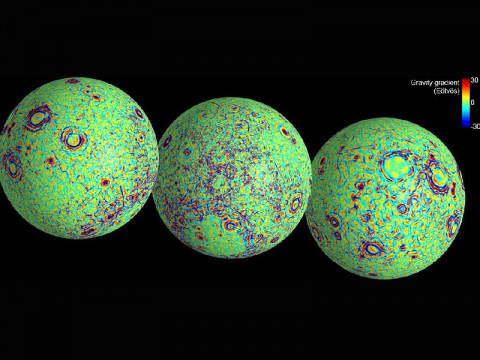Written by DC Agle
NASA’s Jet Propulsion Laboratory
 Pasadena, CA – Twin NASA probes orbiting Earth’s moon have generated the highest resolution gravity field map of any celestial body.
Pasadena, CA – Twin NASA probes orbiting Earth’s moon have generated the highest resolution gravity field map of any celestial body.
The new map, created by the Gravity Recovery and Interior Laboratory (GRAIL) mission, is allowing scientists to learn about the moon’s internal structure and composition in unprecedented detail. Data from the two washing machine-sized spacecraft also will provide a better understanding of how Earth and other rocky planets in the solar system formed and evolved.
[youtube]https://www.youtube.com/watch?v=hFoF9fSxYNI[/youtube]
The gravity field map reveals an abundance of features never before seen in detail, such as tectonic structures, volcanic landforms, basin rings, crater central peaks and numerous simple, bowl-shaped craters. Data also show the moon’s gravity field is unlike that of any terrestrial planet in our solar system.These are the first scientific results from the prime phase of the mission, and they are published in three papers in the journal Science.
“What this map tells us is that more than any other celestial body we know of, the moon wears its gravity field on its sleeve,” said GRAIL Principal Investigator Maria Zuber of the Massachusetts Institute of Technology in Cambridge. “When we see a notable change in the gravity field, we can sync up this change with surface topography features such as craters, rilles or mountains.”
According to Zuber, the moon’s gravity field preserves the record of impact bombardment that characterized all terrestrial planetary bodies and reveals evidence for fracturing of the interior extending to the deep crust and possibly the mantle. This impact record is preserved, and now precisely measured, on the moon.
The probes revealed the bulk density of the moon’s highland crust is substantially lower than generally assumed. This low-bulk crustal density agrees well with data obtained during the final Apollo lunar missions in the early 1970s, indicating that local samples returned by astronauts are indicative of global processes.
The map was created by the spacecraft transmitting radio signals to define precisely the distance between them as they orbit the moon in formation. As they fly over areas of greater and lesser gravity caused by visible features, such as mountains and craters, and masses hidden beneath the lunar surface, the distance between the two spacecraft will change slightly.

“We used gradients of the gravity field in order to highlight smaller and narrower structures than could be seen in previous datasets,” said Jeff Andrews-Hanna, a GRAIL guest scientist with the Colorado School of Mines in Golden. “This data revealed a population of long, linear gravity anomalies, with lengths of hundreds of kilometers, crisscrossing the surface. These linear gravity anomalies indicate the presence of dikes, or long, thin, vertical bodies of solidified magma in the subsurface. The dikes are among the oldest features on the moon, and understanding them will tell us about its early history.”
When launched in September 2011, the probes were named GRAIL A and B. They were renamed Ebb and Flow in January by elementary students in Bozeman, MT, in a nationwide contest. Ebb and Flow were placed in a near-polar, near-circular orbit at an altitude of approximately 34 miles (55 kilometers) on December 31st, 2011, and January 1st, 2012, respectively.
NASA’s Jet Propulsion Laboratory in Pasadena, CA, manages the mission for NASA’s Science Mission Directorate in Washington. GRAIL is part of the Discovery Program managed at NASA’s Marshall Space Flight Center in Huntsville, AL. Lockheed Martin Space Systems of Denver built the spacecraft.
To view the lunar gravity map, visit http://bit.ly/grailtour .
For more information about the mission, visit: http://www.nasa.gov/grail .
JPL is a division of the California Institute of Technology in Pasadena.


